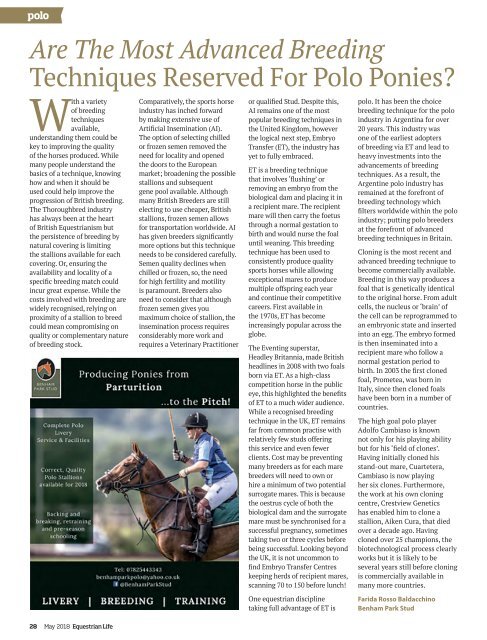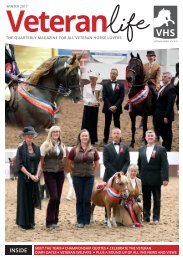Equestrian Life May 2018 Issue
You also want an ePaper? Increase the reach of your titles
YUMPU automatically turns print PDFs into web optimized ePapers that Google loves.
polo<br />
Are The Most Advanced Breeding<br />
Techniques Reserved For Polo Ponies?<br />
With a variety<br />
of breeding<br />
techniques<br />
available,<br />
understanding them could be<br />
key to improving the quality<br />
of the horses produced. While<br />
many people understand the<br />
basics of a technique, knowing<br />
how and when it should be<br />
used could help improve the<br />
progression of British breeding.<br />
The Thoroughbred industry<br />
has always been at the heart<br />
of British <strong>Equestrian</strong>ism but<br />
the persistence of breeding by<br />
natural covering is limiting<br />
the stallions available for each<br />
covering. Or, ensuring the<br />
availability and locality of a<br />
specific breeding match could<br />
incur great expense. While the<br />
costs involved with breeding are<br />
widely recognised, relying on<br />
proximity of a stallion to breed<br />
could mean compromising on<br />
quality or complementary nature<br />
of breeding stock.<br />
Comparatively, the sports horse<br />
industry has inched forward<br />
by making extensive use of<br />
Artificial Insemination (AI).<br />
The option of selecting chilled<br />
or frozen semen removed the<br />
need for locality and opened<br />
the doors to the European<br />
market; broadening the possible<br />
stallions and subsequent<br />
gene pool available. Although<br />
many British Breeders are still<br />
electing to use cheaper, British<br />
stallions, frozen semen allows<br />
for transportation worldwide. AI<br />
has given breeders significantly<br />
more options but this technique<br />
needs to be considered carefully.<br />
Semen quality declines when<br />
chilled or frozen, so, the need<br />
for high fertility and motility<br />
is paramount. Breeders also<br />
need to consider that although<br />
frozen semen gives you<br />
maximum choice of stallion, the<br />
insemination process requires<br />
considerably more work and<br />
requires a Veterinary Practitioner<br />
or qualified Stud. Despite this,<br />
AI remains one of the most<br />
popular breeding techniques in<br />
the United Kingdom, however<br />
the logical next step, Embryo<br />
Transfer (ET), the industry has<br />
yet to fully embraced.<br />
ET is a breeding technique<br />
that involves ‘flushing’ or<br />
removing an embryo from the<br />
biological dam and placing it in<br />
a recipient mare. The recipient<br />
mare will then carry the foetus<br />
through a normal gestation to<br />
birth and would nurse the foal<br />
until weaning. This breeding<br />
technique has been used to<br />
consistently produce quality<br />
sports horses while allowing<br />
exceptional mares to produce<br />
multiple offspring each year<br />
and continue their competitive<br />
careers. First available in<br />
the 1970s, ET has become<br />
increasingly popular across the<br />
globe.<br />
The Eventing superstar,<br />
Headley Britannia, made British<br />
headlines in 2008 with two foals<br />
born via ET. As a high-class<br />
competition horse in the public<br />
eye, this highlighted the benefits<br />
of ET to a much wider audience.<br />
While a recognised breeding<br />
technique in the UK, ET remains<br />
far from common practise with<br />
relatively few studs offering<br />
this service and even fewer<br />
clients. Cost may be preventing<br />
many breeders as for each mare<br />
breeders will need to own or<br />
hire a minimum of two potential<br />
surrogate mares. This is because<br />
the oestrus cycle of both the<br />
biological dam and the surrogate<br />
mare must be synchronised for a<br />
successful pregnancy, sometimes<br />
taking two or three cycles before<br />
being successful. Looking beyond<br />
the UK, it is not uncommon to<br />
find Embryo Transfer Centres<br />
keeping herds of recipient mares,<br />
scanning 70 to 150 before lunch!<br />
One equestrian discipline<br />
taking full advantage of ET is<br />
polo. It has been the choice<br />
breeding technique for the polo<br />
industry in Argentina for over<br />
20 years. This industry was<br />
one of the earliest adopters<br />
of breeding via ET and lead to<br />
heavy investments into the<br />
advancements of breeding<br />
techniques. As a result, the<br />
Argentine polo industry has<br />
remained at the forefront of<br />
breeding technology which<br />
filters worldwide within the polo<br />
industry; putting polo breeders<br />
at the forefront of advanced<br />
breeding techniques in Britain.<br />
Cloning is the most recent and<br />
advanced breeding technique to<br />
become commercially available.<br />
Breeding in this way produces a<br />
foal that is genetically identical<br />
to the original horse. From adult<br />
cells, the nucleus or ‘brain’ of<br />
the cell can be reprogrammed to<br />
an embryonic state and inserted<br />
into an egg. The embryo formed<br />
is then inseminated into a<br />
recipient mare who follow a<br />
normal gestation period to<br />
birth. In 2003 the first cloned<br />
foal, Prometea, was born in<br />
Italy, since then cloned foals<br />
have been born in a number of<br />
countries.<br />
The high goal polo player<br />
Adolfo Cambiaso is known<br />
not only for his playing ability<br />
but for his ‘field of clones’.<br />
Having initially cloned his<br />
stand-out mare, Cuartetera,<br />
Cambiaso is now playing<br />
her six clones. Furthermore,<br />
the work at his own cloning<br />
centre, Crestview Genetics<br />
has enabled him to clone a<br />
stallion, Aiken Cura, that died<br />
over a decade ago. Having<br />
cloned over 25 champions, the<br />
biotechnological process clearly<br />
works but it is likely to be<br />
several years still before cloning<br />
is commercially available in<br />
many more countries.<br />
Farida Rosso Baldacchino<br />
Benham Park Stud<br />
28 <strong>May</strong> <strong>2018</strong> <strong>Equestrian</strong> <strong>Life</strong>
















